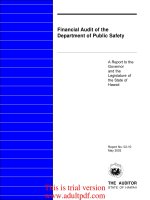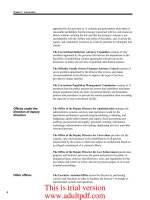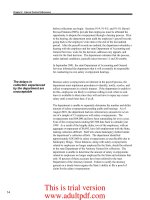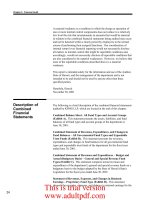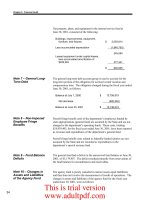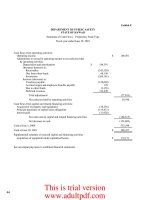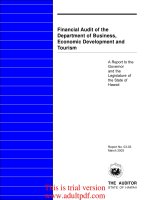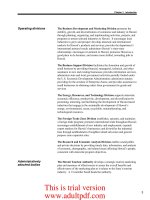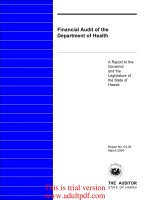Financial Audit of the Department of Public Safety A Report to the Governor and the Legislature of the State of Hawaii Report No. 02-10 May 2002_part5 pot
Bạn đang xem bản rút gọn của tài liệu. Xem và tải ngay bản đầy đủ của tài liệu tại đây (340.31 KB, 11 trang )
38
Chapter 3: Financial Audit
Accumulated Sick Leave
Employees earn sick leave credits at the rate of one and three-quarters
working days for each month of service without limit. Sick leave can be
taken only in the event of illness and is not convertible to pay upon
termination of employment. However, an employee who retires or
leaves government service in good standing with 60 days or more of
unused sick leave is entitled to additional service credit in the ERS.
Accumulated sick leave as of June 30, 2001, amounted to approximately
$19,510,000.
Deferred Compensation Plan
The State offers its employees a deferred compensation plan created in
accordance with Internal Revenue Code Section 457. The plan, available
to all state employees, permits employees to defer a portion of their
salary until future years. The deferred compensation is not available to
employees until termination, retirement, death, or unforeseeable
emergency.
All plan assets are held in a trust fund to protect them from claims of
general creditors and from diversion to any uses other than paying
benefits to participants and beneficiaries. The department has no
responsibility for loss due to the investment or failure of investment of
funds and assets in the plan, but does have the duty of due care that
would be required of an ordinary prudent investor. Therefore, in
accordance with Governmental Accounting Standards Board Statement
No. 32, Accounting and Financial Reporting for Internal Revenue Code
Section 457 Deferred Compensation Plans, deferred compensation plan
assets are not reported in the accompanying combined financial
statements.
The department’s expendable trust fund balance at June 30, 2000 has
been restated to record certain acquisitions of law enforcement
equipment as agency transactions. In previous years, cash receipts and
disbursements for these transactions were recorded in the expendable
trust fund as revenues and expenditures. The effect of recording this
prior period adjustment was to (1) decrease previously reported assets
and fund balance of the expendable trust fund and (2) increase the assets
and liabilities of the agency fund at June 30, 2000, by $1,380,065 as
follows:
Note 14 –
Commitments and
Contingencies
Note 15 – Prior Period
Adjustment
This is trial version
www.adultpdf.com
39
Chapter 3: Financial Audit
Expendable Trust
Fund Agency Fund
Balance at June 30, 2000, as
previously reported
$
1,663,105
$
1,207,081
Adjustment (1,380,065) 1,380,065
Balance at June 30, 2000, as
restated
$
283,040
$
2,587,146
This is trial version
www.adultpdf.com
40
Chapter 3: Financial Audit
Exhibit A
Proprietar
y
Fiduciar
y
Fund T
y
pe Fund T
y
pes General General Totals
Special Capita
l
Internal Trust Fixed Assets Lon
g
-Ter
m
(Memorandu
m
General Revenue Pro
j
ects Service and A
g
enc
y
(Unaudited) Debt Onl
y
)
Cash (note 4) $ 10,110,781 $ 2,910,497 $ 297,510 $ 398,477 $ 2,430,652 $ — $ — $ 16,147,917
Receivables, net (note 5) 1,169,426 — — 863,492 — — — 2,032,918
Due from other funds — 224,158 — 51,232 95,493 — — 370,883
Due from others — 75,264 — — — — — 75,264
Due from State of Hawaii 913,205 — — — — — — 913,205
Inventories — — — 531,907 — — — 531,907
Net property, plant, and equipment (note 6) — — — 622,505 — 133,961,310 — 134,583,815
Amount to be provided for retirement of general long-term debt — — — — — — 13,136,274 13,136,274
Total assets $ 12,193,412 $ 3,209,919 $ 297,510 2,467,613 $ 2,526,145 $ 133,961,310 $ 13,136,274 $ 167,792,183
Liabilities:
Vouchers payable $ 3,631,855 $ 41,416 $ — $ 525,433 $ 28,013 $ — $ — $ 4,226,717
Accrued wages and employee benefits payable (note 7) 5,071,798 136,597 — 82,106 — — 13,136,274 18,426,775
Due to other funds 128,407 454 — 17,864 224,158 — — 370,883
Due to individuals — — — — 924,656 — — 924,656
Due to others — — — — 1,058,424 — — 1,058,424
Capital lease obligations (note 11) — — — 352,781 — — — 352,781
Deferred revenues — 163,299 250 312,249 — — — 475,798
Total liabilities 8,832,060 341,766 250 1,290,433 2,235,251 — 13,136,274 25,836,034
Fund equity and other credit:
Investment in general fixed assets — — — — — 133,961,310 — 133,961,310
Retained earnings — — — 1,177,180 — — — 1,177,180
Fund balances:
Reserved for encumbrances 5,371,833 399,180 — — 3,207 — — 5,774,220
Reserved for future appropriations — — 297,260 — — — — 297,260
Reserved for receivables 1,169,426 — — — — — — 1,169,426
Unreserved (note 9) (3,179,907) 2,468,973 — — 287,687 — — (423,247)
Total fund equity and other credit 3,361,352 2,868,153 297,260 1,177,180 290,894 133,961,310 — 141,956,149
Total liabilities and fund equity and other credit $ 12,193,412 $ 3,209,919 $ 297,510 $ 2,467,613 $ 2,526,145 $ 133,961,310 $ 13,136,274 $ 167,792,183
See accompanying notes to combined financial statements.
DEPARTMENT OF PUBLIC SAFET
Y
STATE OF HAWAII
Combined Balance Sheet – All Fund Types and Account Groups
June 30, 2001
Account Groups
Assets
Liabilities and Fund Equity and Other Credit
Governmental Fund Types
This is trial version
www.adultpdf.com
41
Chapter 3: Financial Audit
Exhibit B
Fiduciar
y
Fund Type Totals
Special Capital Expendable (Memorandu
m
General Revenue Projects Trust Only)
Revenues:
State allotted appropriations, net of lapses $ 131,608,092 $ — $ — $ — $ 131,608,092
Intergovernmental — 995,349 107,257 — 1,102,606
Interest — — — 24,906 24,906
Other (note 8) 18,939,403 3,204,553 — 18,293 22,162,249
150,547,495 4,199,902 107,257 43,199 154,897,853
Expenditures:
Confinemen
t
111,244,359 681,598 — — 111,925,957
Enforcement 10,217,712 2,224,776 — — 12,442,488
Parole supervision and counseling 2,314,362 — — — 2,314,362
Criminal injuries compensation — 1,629,515 — — 1,629,515
General support – criminal action 28,781,243 — — — 28,781,243
Capital outla
y
— — 107,257 — 107,257
Other — — — 35,345 35,345
152,557,676 4,535,889 107,257 35,345 157,236,167
Excess (deficiency) of revenues over expenditures (2,010,181) (335,987) — 7,854 (2,338,314)
Other financing sources (uses):
Operating transfers in — 877,025 — — 877,025
Operating transfers out (1,171,673) — — — (1,171,673)
(1,171,673) 877,025 — — (294,648)
Excess (deficiency) of revenues and other sources over expenditures and
other uses (3,181,854) 541,038 — 7,854 (2,632,962)
Fund balances at July 1, 2000, as restated (note 15) 6,543,206 2,327,115 297,260 283,040 9,450,621
Fund balances at June 30, 2001 $ 3,361,352 $ 2,868,153 $ 297,260 $ 290,894 $ 6,817,659
See accompanying notes to combined financial statements.
Governmental Fund Types
Combined Statement of Revenues, Expenditures, and Changes in Fund Balances
DEPARTMENT OF PUBLIC SAFET
Y
STATE OF HAWAII
– All Governmental Fund Types and Expendable Trust Funds
Fiscal year ended June 30, 2001
This is trial version
www.adultpdf.com
42
Chapter 3: Financial Audit
Exhibit C
Varianc
e
Varianc
e
Variance
Favorabl
e
Favorabl
e
Favorabl
e
Bud
g
et Actual (Unfavorable) Bud
g
et Actual (Unfavorable) Bud
g
et Actual (Unfavorable)
Revenues:
State allotted appropriations,
net of lapse
s
$ 135,394,505 $ 131,608,092 $ (3,786,413) $ — $ — $ — $ 135,394,505 $ 131,608,092 $ (3,786,413)
Intergovernmenta
l
— — — 1,963,296 953,870 (1,009,426) 1,963,296 953,870 (1,009,426)
Othe
r
— — — 6,470,716 3,176,367 (3,294,349) 6,470,716 3,176,367 (3,294,349)
135,394,505 131,608,092 (3,786,413) 8,434,012 4,130,237 (4,303,775) 143,828,517 135,738,329 (8,090,188)
Expenditures:
Confinemen
t
95,958,932 94,649,832 1,309,100 2,956,198 863,560 2,092,638 98,915,130 95,513,392 3,401,738
Enforcement 8,946,081 8,813,837 132,244 3,370,839 2,105,454 1,265,385 12,316,920 10,919,291 1,397,629
Parole supervision
and counseling 2,079,302 2,022,213 57,089 — — — 2,079,302 2,022,213 57,089
Criminal injuries compensation — — — 2,984,000 1,613,609 1,370,391 2,984,000 1,613,609 1,370,391
General support –
criminal action 27,533,165 26,685,643 847,522 — — — 27,533,165 26,685,643 847,522
134,517,480 132,171,525 2,345,955 9,311,037 4,582,623 4,728,414 143,828,517 136,754,148 7,074,369
Excess (deficiency)
of revenues over
expenditure
s
877,025 (563,433) (1,440,458) (877,025) (452,386) 424,639 — (1,015,819) (1,015,819)
Other financing sources (uses):
Operating transfers in — — — 877,025 877,025 — 877,025 877,025 —
Operating transfers ou
t
(877,025) (1,171,673) (294,648) — — — (877,025) (1,171,673) (294,648)
(877,025) (1,171,673) (294,648) 877,025 877,025 — — (294,648) (294,648)
Excess (deficiency)
of revenues
and other source
s
over expenditure
s
and other uses $ — $ (1,735,106) $ (1,735,106) $ — $ 424,639 $ 424,639 $ — $ (1,310,467) $ (1,310,467)
See accompanying notes to combined financial statements.
General Fun
d
Totals (Memorandum Onl
y
)Special Revenue Funds
DEPARTMENT OF PUBLIC SAFETY
STATE OF HAWAII
Combined Statement of Revenues and Expenditures – Budget and Actual (Budgetary Basis)
General and Special Revenue Fund Types
Fiscal year ended June 30, 2001
This is trial version
www.adultpdf.com
43
Chapter 3: Financial Audit
Exhibit D
Operating revenues – charges for sales and services $ 4,999,860
Operating expenses:
Cost of sales and services $ 4,693,668
Depreciation and amortization (note 11) 184,391
Provision for uncollectible accounts 13,300
4,891,359
Operating income 108,501
Nonoperating expense – interest (31,928)
Net income 76,573
Retained earnings at July 1, 2000 1,100,607
Retained earnings at June 30, 2001 $ 1,177,180
See accompanying notes to combined financial statements.
Fiscal year ended June 30, 2001
DEPARTMENT OF PUBLIC SAFETY
STATE OF HAWAII
Statement of Revenues, Expenses, and
Changes in Retained Earnings – Proprietary Fund Type
This is trial version
www.adultpdf.com
44
Chapter 3: Financial Audit
Exhibit E
Cash flows from operating activities:
Operating income $ 108,501
Adjustments to reconcile operating income to net cash provided
b
y operating activities:
Depreciation and amortization $ 184,391
(Increase) decrease in:
Receivables (243,328)
Due from other funds 68,150
Inventories (268,161)
Increase (decrease) in:
Vouchers payable (128,009)
Accrued wages and employee benefits payable 129
Due to other funds (3,376)
Deferred revenues 312,249
Total adjustments (77,955)
Net cash provided by operating activities 30,546
Cash flows from capital and related financing activities:
Acquisition of property and equipment (38,256)
Principal payments on capital lease obligations (114,431)
Interest paid (31,928)
Net cash used in capital and related financing activities (184,615)
Net decrease in cash (154,069)
Cash at July 1, 2000 552,546
Cash at June 30, 2001 $ 398,477
Supplemental schedule of noncash capital and financing activities –
acquisition of equipment under capitalized leases $ 172,171
See accompanying notes to combined financial statements.
Fiscal year ended June 30, 2001
DEPARTMENT OF PUBLIC SAFETY
STATE OF HAWAII
Statement of Cash Flows – Proprietary Fund Type
This is trial version
www.adultpdf.com
45
Notes
Notes
Chapter 2
1. The U.S. Bureau of Labor Statistics, "Current Population Survey
2000 Annual Averages."
This is trial version
www.adultpdf.com
4446
Chapter 1: Introduction
This page is intentionally left blank
This is trial version
www.adultpdf.com
47
Comments on
Agency Response
Response of the Affected Agency
We transmitted a draft of this report to the Department of Public Safety
(department) on April 25, 2002. A copy of the transmittal letter to the
department is included as Attachment 1. The response of the department
is included as Attachment 2.
The department responded that it appreciates that we recognized the
work that has been done in its specific problem areas; however, the
department believes that the report paints an incomplete and unfair
picture. Yet the department has accepted several of our
recommendations.
The department believes that our report oversimplifies the problems that
exist with overtime. The department reports that “all seven-day-per-
week, 24-hour-per-day operations will incur some level of overtime
because no matter what the circumstance, staff must provide a certain
level of coverage to maintain security and safety.” The department notes
that some facilities, especially the Women’s Community Correctional
Center and the Hawaii Community Correctional Center, have special
challenges such as gender-specific posts and inmate transportation
issues. While these examples may be relevant, overtime costs at 13
percent of total salary expense are still unacceptable and the department
must continue to work on improving the overtime incurred.
Concerning our finding regarding the alleged sick leave abuse at the
Waiawa Correctional Center and the Women’s Community Correctional
Center, the department’s response is misdirected. It was the
department’s own staff who stated that the alleged abuse was not
investigated because no clear evidence existed. But if an investigation is
not made into the allegations, how can the department make the
determination that “no clear evidence” exists? The allegations that sick
leave was used when employees were denied vacation leave and that
employees used sick leave time to care for their children during breaks
from school could have been easily researched. We stand by our
recommendation that any apparent abuse of sick leave should be
investigated in a timely manner.
The department has stated that it is unfair to compare ACOs’ levels of
sick leave usage with that of other state agencies and national averages.
We understand the department’s concerns with the comparison; however,
an average of 27 sick leave days taken during the fiscal year ended June
30, 2001 for all uniformed staff, which includes ACOs and medical and
food service staff, is extremely high. The average of 27 sick leave days
This is trial version
www.adultpdf.com
48
taken is more than twice the national average of 12 for all government
employees, as stated in our report. It is also higher than the 21 days of
sick leave days per year earned by employees hired before July 2001,
which the department has stated is a “very liberal leave policy.” Once
again, we stand by our finding that the continued unusual sick leave
patterns and the high levels of sick leave usage raise doubts about the
effectiveness of the department’s sick leave abuse program.
The department states that our report implies that “three ACOs had high
overtime despite poor attendance records.” This is an incorrect
statement. Our report does not make that implication. Our report
identifies two different samples used to test overtime and sick leave.
The overtime sample consisted of 21 ACOs, two food service staff, and
two medical staff. The sick leave sample consisted of 22 ACOs and
three food service staff. Also, for the three individuals with overtime
compensation greater than their base compensation, our report does not
identify whether they are ACOs, food service staff, or medical staff.
The department disagrees that “[t]he delays in collection experienced by
the department are unacceptable.” The department further discusses
what it has done to mitigate the salary overpayment problem. While we
commend the department for its efforts, the fact remains that as of June
30, 2001, $1.8 million in salary overpayments remained uncollected. We
understand the difficulties involved in the process, but consider $1.8
million a significant amount. The longer the balances remain
outstanding, the more difficult it becomes to collect on them.
This is trial version
www.adultpdf.com
